1. Introduction
 Haicom is a leading company in the GPS arena, offering Bluetooth and CompactFlash (CF) GPS devices geared for specific user groups. Haicom kindly offered us the chance to test the Haicom 305III and compare it with another well known device from rival Globalsat, the BC-337. Which CF GPS receiver performed better and which offers more? Read on to find out!
Haicom is a leading company in the GPS arena, offering Bluetooth and CompactFlash (CF) GPS devices geared for specific user groups. Haicom kindly offered us the chance to test the Haicom 305III and compare it with another well known device from rival Globalsat, the BC-337. Which CF GPS receiver performed better and which offers more? Read on to find out!
- Haicom 305III
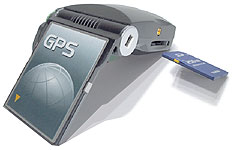 The HI-305III is a GPS receiver with Compact Flash type I / mini-1394 interfaces and built-in active antenna for high sensitivity to tracking signal. It is based on the SiRF star III Ultra high sensitive chipset and supports all functions (Single Sat updates in reduced visibility, Superior urban canyon performance, Foliage Lock for weak signal tracking, etc.).
The HI-305III is a GPS receiver with Compact Flash type I / mini-1394 interfaces and built-in active antenna for high sensitivity to tracking signal. It is based on the SiRF star III Ultra high sensitive chipset and supports all functions (Single Sat updates in reduced visibility, Superior urban canyon performance, Foliage Lock for weak signal tracking, etc.).
The HI-305III is well suited to system integration and for users who use any kinds of mobile devices, such as PDAs, notebook PCs, Tablet PCs, etc. It satisfies a wide variety of applications for car navigation, personal navigation or touring devices, tracking and marine navigation purposes. Users can simply plug it into a PDA or other type of handheld PC running suitable mapping and routing software for navigation.
- Used chipset
The SiRF III chipset has the following specifications:
| Chipset: |
SiRF Star III WAAS enabled |
| Frequency: |
1, 1575.42 MHz |
| C/A code: |
1.023 MHz chip rate |
| Channels: |
20 channel all-in-view tracking |
| Position Accuracy: |
10 meters, 2D RMS |
| ~ 5 meters, 3D RMS WAAS |
| Velocity: |
0.1 m/s |
| Time: |
us synchronized to GPS time |
| Default: |
WGS-84 Acquisition Time (Open sky, stationary) |
| Reacquisition: |
0.1 sec., average |
| Hot start: |
1 sec., average |
| Warm start: |
38 sec., average |
| Cold start: |
42 sec., average |
| Altitude: |
18,000 meters (60,000 feet) max. |
| Velocity: |
515 meters/second (1000 knots) max. |
| Acceleration: |
Less than 4g |
| Jerk: |
20 m/sec |
| Protocol messages: |
NMEA-0183 output protocol |
| Output format: |
GGA(1sec), GSA(5sec), GSV(5sec), RMC(1sec),VTG(1sec) |
| Operating temperature: |
-20° to 60° C |
| Humidity: |
5% to 95% Non-condensing |
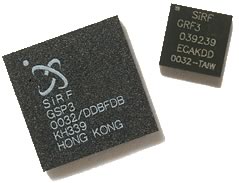
Looking at the SiRF III specs, we can see that the chipset is capable of receiving up to 20 satellites (actually 12 maximum), has very low Hot/Warm/Cold start times and its accuracy reaches ~5m when the WAAS mode is enabled.
2. Features
- 20 Channels "All-In-View" Tracking
- Position accuracy of 10 meters 2D RMS
- Cold/Warm/Hot Start Time: 42/38/1 Seconds (Signal Strength > 30 dB-HZ)
- Reacquisition Time: 0.1 seconds
- Support Standard NMEA-0183 at 38400 bps baud rate (Defined by customer 4800 up to 57600)
- Support Power Saving Mode
- Features SD Slot
- Superior Sensitivity for Urban Canyon and Foliage Environment
- Ultra s mall, sleek, and lightweight design easily fits in your hand
For our test purposes, Haicom sent us the retail package that includes:
- the HI-305III GPS receiver itself
- a carrying pouch
- a male mini-1394 to PS/II connecting cable
- a PS/II to DB9 serial connecting cable (optional)
- a CD-ROM with corresponding software
- a printed user manual
The current price for the product is around US$99, as found around the net.

The contents of the retail package are shown below (apart from for the PS/II to DB9 serial connecting cable):
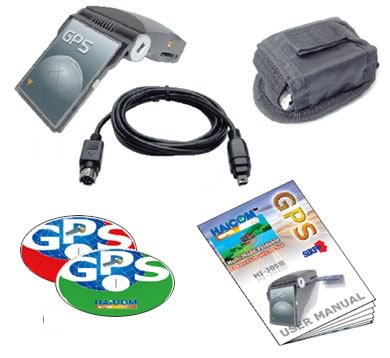
By using different optional connections, the HI-305III offers all kinds of wired GPS receiver solutions.
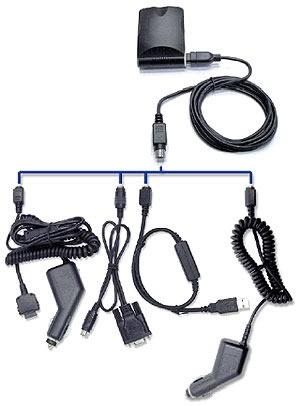
The HI-305III can be virtually any type of GPS receiver, such as
CompactFlash GPS, USB GPS, Bluetooth GPS, Serial GPS, Any PDA
GPS, etc. You won't need to buy several GPS receivers to fit your
mobile devices, like Notebook PCs, Tablet PCs, PDAs, etc. With the HI-305III,
one unit fits all interfaces.
Apart from using it as a complete GPS solution, the HI-305III can also be used as a SD card reader with the CF interface. You can store any file onto any standard SD memory card and the file can be read or written to from the Compact Flash interface. After the proper driver is installed and with the SD memory card inserted, as soon as the Compact Flash interface is plugged into any PC, a folder is created on the host device.

A full list of optional accessories can be found below:
 Model Name Model Name |
Model # |
 |
| 1. MMCX external antenna |
ATN-MMC |
 |
| 2. CF-PCMCIA adapter |
CF-PCM |
 |
| 3. PS/II to USB connecting cable |
PS2-USB |
 |
| 4. PS/II to DB9 serial connecting cable |
PS2-DB9 |
 |
| 5. PS/II to PDA connecting cable/charger |
PS2-XXX |
 |
| 6. Bluetooth Slipper |
HI-401BT |
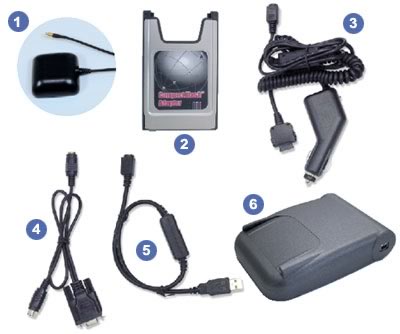
The following picture shows the device and we can get an idea of its size. The HI-305III can be bent at an angle anywhere from 0° to 180° to
accommodate the best satellite receiving angle. On the side of the HI-305III,
there is the SD memory
slot. Users can insert their
SD memory card
containing mapping
software so that the GPS
and map data
can be accessed
simultaneously via the
Compact Flash interface
through a host device like a
PDA, laptop PC, etc.

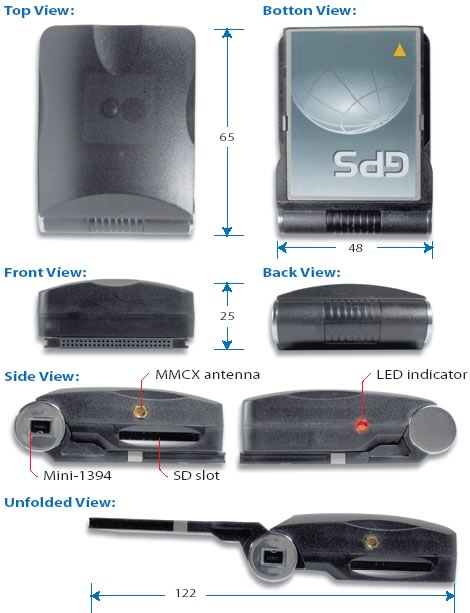
On the top, we have thee charger interface (mini USB) and the external cable jack (MMCX compatible). The led flashes when the 3D Position is fixed and on when a signal is being searched. Comparing the HI-305 III with the Globalsat BT-338 in size, we can see that it's somewhat smaller although wider:


After installing the HI-305III on a Dell Axim x50V, we set it up so that we got the best signal strength. As was mentioned earlier, the device can swivel open, up to a maximum of 180° to achieve the optimum angle when searching for a signal.


3. Installation
The installation process for Haicom 305-III differs depending on which interface connection you choose. In our case, (Dell Axim x50V with Windows Mobile 2003 SE), the installation process was very easy, just plug the device into the CF slot and... a popup window prompts you to type a name for the 305III GPS receiver. We also noticed the following happens every time the device shuts down or you simply remove the 305III receiver...
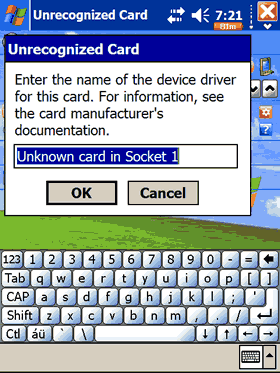
In the event you want to use the included SD slot, you have to install a device driver called elSDMMC, with however several limitations:
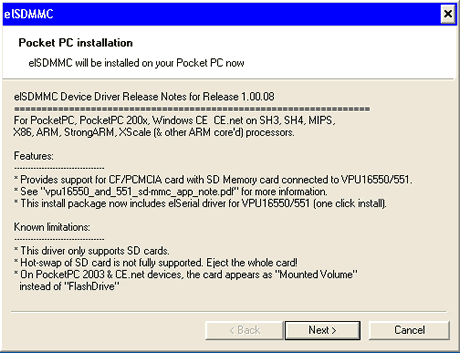
After soft-resetting your PDA, and assuming you have inserted the SD card BEFORE powering up the PDA, a new folder will show up under MyDevice as "Mounted Volume". The 305III was recognized without a hitch, as an Apacer 2GB SD card. As the device driver indicates, you cannot hot-swap SD cards, which is rather inconvenient. We are not very sure if this drive will work well under WM5, or if the device is supported at all...

Since the Haicom 305-III uses the SiRFIII chipset, we were able to retrieve several pieces of information about the factory settings, such as firmware revision, if static navigation is turned on or off, etc:


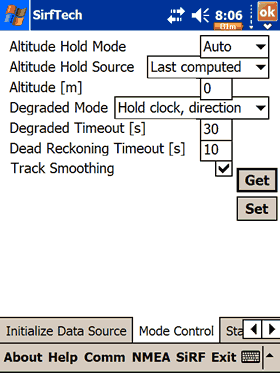




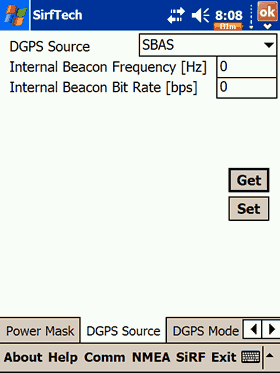
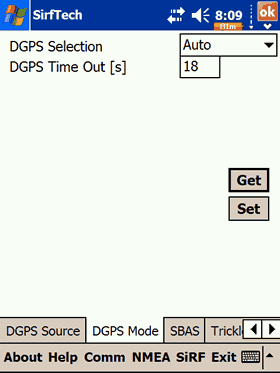



4. The Tests
- Tests Day One
We tested the device with a Dell Axim X50v. We recorded all produced data for a pre-selected route with VisualGPSce (free edition) and later analyzed it with GPSLog. In order to measure the TTFF tests ("Time to First Fix" which is the time it takes for a GPS to determine its current position), we used GPSInfo "Cold Start" function. All tests ran continuously, under the same environmental conditions (night, clear sky, 15° C ) and driving in an Audi A4, 2004.
|
Globalsat BC-337 |
Haicom HI-305III |
|
Time to First Fix (TTFF) |
Secs |
48.5 sec |
42.33 sec |
|
Fix |
Invalid |
6.6 |
0 |
|
2D |
7.0 |
1.7 |
3D
|
86.4 |
98.3 |
|
Satellites |
Average (in view) |
10.00 |
8.00 |
|
Average (in use) |
4.14 |
5.34 |
|
Average Signal Level (in dB) |
Maximum per Satellite |
39.40 |
40.50 |
|
Average per Satellite |
32.04 |
33.12 |
The Haicome HI-305III performed well in all tests. Its TTFF time was shorter than the BC-337s' and the device had a very low percentage (%) of Invalid and 2D fix. The Average Satellites in "view", were higher than with the Globalsat BC-337. Lastly, the Average Signal Levels (max/average) per satellite were better than with the BC-337.
- Tests Day Two
Same testbed, Dell Axim X50v, VisualGPSce (free edition), GPSLog and GPSInfo. All tests ran continuously, under the same environmental conditions (day, cloudy weather, 4° C ) and driving in an Audi A4, 2004. This time we used an external antenna to see if there is any difference.
|
Globalsat BC-337 + antenna |
Haicom HI-305III + antenna |
Time to First Fix (TTFF) |
Secs |
29 sec |
37 sec |
Fix |
Invalid |
0 |
0 |
2D |
0 |
0 |
|
100 |
100 |
Satellites |
Average (in view) |
10.00 |
9.17 |
Average (in use) |
6.91 |
6.94 |
Average Signal Level (in dB) |
Maximum per Satellite |
45.57 |
43.50 |
Average per Satellite |
36.89 |
36.01 |
Using an external antenna gave us different results, with the BC-337 performing better. Both devices lowered their TTFF times, had higher satellites "in use" and Average Signal Levels (max/average) per satellite, compared with the antenna-less results.
5. Conclusion
 The Haicom 305-III is a good product with easy installation of a CF card (no drivers required), while at the same time it can be connected using a number of different interfaces, ranging from serial and CF up to USB and Bluetooth, provided that you use the special connection cables. What it boils down to is that you buy one product that can be used with almost all available connection interfaces available on modern desktop PCs, laptops and of course, PDA devices.
The Haicom 305-III is a good product with easy installation of a CF card (no drivers required), while at the same time it can be connected using a number of different interfaces, ranging from serial and CF up to USB and Bluetooth, provided that you use the special connection cables. What it boils down to is that you buy one product that can be used with almost all available connection interfaces available on modern desktop PCs, laptops and of course, PDA devices.
Since the HI-305-III uses the SiRF III chipset, it exhibited very good behaviour in terms of sensitivity and ability to "view" many satellites. The ability to connect an external antenna, further boosts the devices capabilities. Users will find the SD slot convenient, even though there are some limitations (no hot-swapping).
The listed price is around US$99, which make it more expensive than the Globalsat BC-337 (US$85). However, it offers greater expandability and its performance won't let you down.
The Positive
- SiRF III chipset with latest firmware (3.1.1)
- Can be used with a variety of connection interfaces (CF, USB, BT, Serial) with optional cables
- Adds an additional SD slot to the host
- Almost complete retail package
- Very good performance
- Easy installation
- External antenna can be connected (optional cable)
- Firmware can be updated through Haicom Viewer software
The Negative
- PCMCIA adapter isn't included
- A little on the large side
- You cannot hot-swap the SD card in the built-in slot